Are you a Quiet Speculation member?
If not, now is a perfect time to join up! Our powerful tools, breaking-news analysis, and exclusive Discord channel will make sure you stay up to date and ahead of the curve.
The metagame is beginning to take form, and now is the time for players to start adapting. This could mean adjusting which decks they play, how they play them, or what cards they play. Now is naturally a time for experimentation, but no such transitional period is free from common mistakes. Whether it's misunderstanding how a deck actually plays to what actually matters in the matchup, there's a lot of strategic ground being misevaluated and conceded. Today, I'll cover and correct the more questionable choices being made.
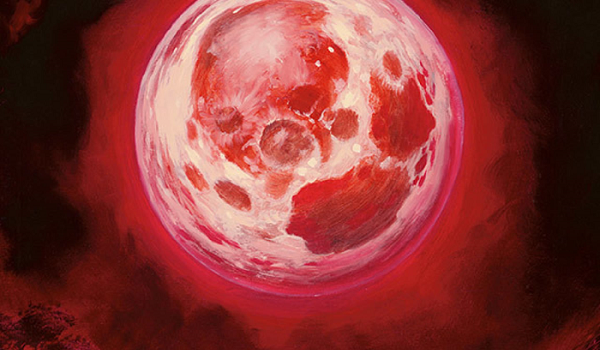
I've been watching the metagame slowly develop for the past several weeks. The initial assumption, based primarily on MTGO data, was that Amulet Titan, Mono-Red Prowess, Dredge, Jund, and Burn were the top dogs. Since then, Prowess has performed up to expectations, Amulet Titan has not, Dredge has disappeared, Burn has been eclipsed by Prowess, Company decks have surged, and Jund just "Junds along," as ever. I'll focus on Titan, Prowess, and Company decks today; what works, what doesn't, and what to play for some blowout spice in your life.
Answering the Titans
There was a time when Amulet Titan was a fairly straightforward land-combo deck. Play Amulet of Vigor, find Primeval Titan, find Sunhome, Fortress of the Legion, deal absurd damage. In this simpler era, the correct choice was to attack the Titans. Thanks to Field of the Dead and Dryad of the Ilysian Grove, that strategy is no longer effective. Titan is still the heart of the deck, but removing doesn't guarantee a win. Now, it's critical to target Amulet of Vigor.
What I'd Use
This section is for those cards that are proven effective against the deck in question. By either attacking the critical resource or answering the right problem, these cards are my first choice against the deck in question. Against Amulet, removing Titan or neutering it aren't enough without additional plans or adequate pressure. The cards I'll be highlighting are damaging enough that Titan has to answer them.
Blood Moon
 There was a time when Blood Moon was considered a clean kill against Amulet Titan. Then, Titan upped its basic count, and while Moon was still crippling, it was no longer deadly. We've come full circle: Moon is increasingly devastating against Titan. To make room for all the new nonbasic toys Wizards has made, Titan decks have been cutting Forests. Because of timestamps, Moon overrides a previously-played Dryad, and even if Dryad came second, all those special lands still lose their non-mana producing effects.
There was a time when Blood Moon was considered a clean kill against Amulet Titan. Then, Titan upped its basic count, and while Moon was still crippling, it was no longer deadly. We've come full circle: Moon is increasingly devastating against Titan. To make room for all the new nonbasic toys Wizards has made, Titan decks have been cutting Forests. Because of timestamps, Moon overrides a previously-played Dryad, and even if Dryad came second, all those special lands still lose their non-mana producing effects.
Damping Sphere
Despite being (typically) one-sided, Sphere is weaker than Blood Moon, though still a solid card. Like Moon, it shuts down Amulet's special acceleration and significantly delays (if not just prevents) casting Titan. The Karoo lands and Castle Garenbrig are pretty anemic as Wastes. However, Sphere does nothing against Valakut or Field. Sphere is therefore weaker than Moon, though it's a fine card for decks that can't accommodate the enchantment.
What Not to Use
There are some cards that just aren't effective, but I've seen lots of players try anyway (prompting this article in the first place). Either they don't attack correctly, are too narrow, or are too easily overcome by the target deck. In Amulet's case, the problem is that a lot of players approach the deck from its older roots or treat it like another big-mana deck. This ignores the reality of the new Amulet mana base and gameplay.
Alpine Moon
Alpine Moon is decent at shutting off one critical land, particularly if that land is named Valakut, the Molten Pinnacle. When Amulet was just comboing lands with Titan, Moon was similarly fine. However, Amulet now has multiple critical lands. Regardless of which land is named, there's another to take its place. Name Castle Garenbrig, Amulet plays Simic Growth Chamber. Name Field of the Dead, and Amulet fetches up Valakut. Couple with all the extra land drops, and shutting off the special text without eliminating useful mana doesn't work against Amulet any more.
Fulminator Mage
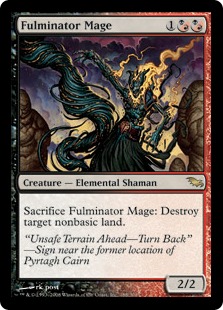 Mage and other one-shot destruction effects are not effective against Amulet. Field of Ruin was a beating for previous versions and made the matchup reasonable for UW Control, but Amulet has changed. Sakura-Tribe Scout always represents a chance to bounce the targeted land with Simic Growth Chamber, especially since Castle Garenbrig obviates the need to actually use Chamber for mana. Mage was previously critical for keeping Amulet off six mana, but now Amulet has too many land drops to keep it down forever. Garenbrig reduces the number of necessary lands for a Titan cast anyway, meaning clever sequencing by the Amulet player usually just dodges one-shots.The plan can still work by looping Mage with Thunderkin Awakener and Incandescent Soulstoke, but such a plan is by no means splashable.
Mage and other one-shot destruction effects are not effective against Amulet. Field of Ruin was a beating for previous versions and made the matchup reasonable for UW Control, but Amulet has changed. Sakura-Tribe Scout always represents a chance to bounce the targeted land with Simic Growth Chamber, especially since Castle Garenbrig obviates the need to actually use Chamber for mana. Mage was previously critical for keeping Amulet off six mana, but now Amulet has too many land drops to keep it down forever. Garenbrig reduces the number of necessary lands for a Titan cast anyway, meaning clever sequencing by the Amulet player usually just dodges one-shots.The plan can still work by looping Mage with Thunderkin Awakener and Incandescent Soulstoke, but such a plan is by no means splashable.
Unmoored Ego
Extraction effects are only good when they're extracting critical cards from a fragile deck. This used to apply to Amulet, and naming Primeval Titan with Ego or Lost Legacy was usually game over. Field of the Dead and Valakut have gutted this strategy. Titan makes those kills much easier, but Amulet can make it happen without Titan now. These lands are also only one- or two-ofs, so Ego can't effectively neuter Amulet either. Thus, the cards end up being tempo-negative and ineffective.
The Spicy Tech
This is where we get to have some fun. Cards in this category aren't necessarily reliable or tournament-winning, but they also cards the opponent is unlikely to consider or plan to play around. So their blowout potential is staggering.
Choke/Boil
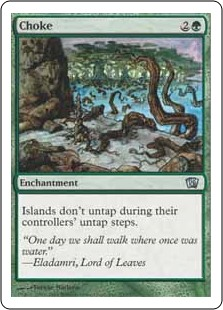 If you've ever wondered how good players can fall to Ponza's darkside, cast Boil in response to a Dryad of the Ilysian Grove-fueled Valakut kill with Field of the Dead triggers. It's the greatest blow-out high you can experience in Magic and you will start thinking that Ponza is a good deck. Doing so after they Summoner's Pacted for Primeval Titan for said win is like [analogy censored].
If you've ever wondered how good players can fall to Ponza's darkside, cast Boil in response to a Dryad of the Ilysian Grove-fueled Valakut kill with Field of the Dead triggers. It's the greatest blow-out high you can experience in Magic and you will start thinking that Ponza is a good deck. Doing so after they Summoner's Pacted for Primeval Titan for said win is like [analogy censored].
Similarly, Choke is less costly and already sees sideboard play against blue decks. Choke is less decisive than Boil since it can be destroyed, but as a response to a big (and hopefully Pact-fueled turn) turn, Choke can still be devastating. It's not a plan that will work out consistently since it depends on the opponent playing Dryad first, but as a one-of blow out, Choke and Boil are almost better than [analogy EXTREMELY censored].
Surviving the Rush
Mono-Red Prowess has been supplanting Burn as the premier red aggro deck in Modern. It's had very strong showings on the SCG Tour. It has a somewhat better matchup against Amulet Titan because it frontloads its damage, making it harder for Titan to stabilize with Radiant Fountain. Prowess also plays a more flexible sideboard, which includes Blood Moon. However, another potentially significant factor is cost. According to pricing information from MTGGoldfish's buying guide, purchasing Prowess in paper costs ~$270, which is a pittance in Modern. Burn, meanwhile, will run to $450 or more. Either through good positioning or being more accessible, Prowess is the deck to prepare against.
What I'd Use
While it is tempting to simply cross-apply all the Burn hate to Prowess, doing so is incorrect. While derived from the same strategic premise, their methodology diverges enough that hate doesn't function perfectly. Burn's creatures are really just glorified burn spells, while Prowess is all about massive, velocity-fueled attacks. This gives Prowess a speed advantage at the cost of lowered inevitability, or a harder time closing if the creatures don't connect; that failing should be exploited by players looking to beat the deck.
mtg_card]Kor Firewalker[/mtg_card]
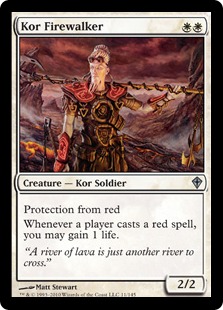 Kor Firewalker is frequently overplayed against regular Burn. Protection is nice to roadblock creatures or dodging Searing Blaze, but the lifegain is just buying time. Firewalker essentially prevents one damage from each burn spell, which isn't awful, but won't totally prevent fiery death. Prowess's burn spells are fewer and frequently smaller, so the lifegain is more significant. Prowess also plays non-burn red spells, so Firewalker can actually plus on life. The additional creatures mean that blocking is more important. Just watch out for Shrine of Burning Rage, which sidesteps Firewalker entirely.
Kor Firewalker is frequently overplayed against regular Burn. Protection is nice to roadblock creatures or dodging Searing Blaze, but the lifegain is just buying time. Firewalker essentially prevents one damage from each burn spell, which isn't awful, but won't totally prevent fiery death. Prowess's burn spells are fewer and frequently smaller, so the lifegain is more significant. Prowess also plays non-burn red spells, so Firewalker can actually plus on life. The additional creatures mean that blocking is more important. Just watch out for Shrine of Burning Rage, which sidesteps Firewalker entirely.
Circle of Protection: Red
Similarly, Circle: Red is not effective against Burn. It's a huge tempo hole, and Burn will just wait until it can overwhelm Circle on mana. Or worse, Skullcracking first renders Circle dead cardboard. However, Prowess doesn't play Skullcrack, and its actual burn count is lower. Thus, it's easier to be strategic with prevention shields. It's not necessary to stop attacks every turn; just when the creatures have been pumped several times. Therefore, more mana is available to advance the board and actually stabilize.
What You Shouldn't Use
Timely Reinforcements
Timely is one of the best anti-Burn cards around, leading many to think it is equally effective against Prowess. The mistake is that Timely is great against Burn because the lifegain trades with two burn spells and the tokens represent at least another 3 life from chump blocks. Burn is very good at dealing 20; getting more is asking a lot. Because Prowess runs more creatures and thus more persistent sources of damage, they can overcome lifegain more easily. Adding insult to injury is Crash Through. Where it can take Burn multiple turns to erase a single Timely Reinforcements, a couple Prowess creatures, a Crash, and any other spell erase Timely immediately, rendering it a minor speed bump at best.
Collective Brutality
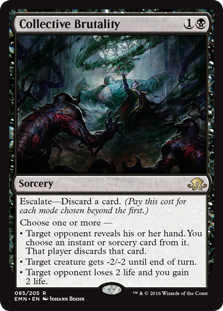 Brutality is phenomenal against Burn for similar reasons. A fully-escalated Brutality kills a Goblin Guide, discards a burn spell, and drains to nullify most of another spell. This is a huge tempo swing against Burn. While making Prowess discard cards is fine, the rest of Brutality doesn't do enough. There is no guarantee Brutality will kill anything thanks to prowess, and even if it does, there will be more creatures. As mentioned, Prowess excels at dealing chunks of damage, so a drain can't provide the same cushion. All that's left is the discard, leaving Brutality as an overpriced Duress. The tempo swing is too low for Brutality to be a main plan against Prowess.
Brutality is phenomenal against Burn for similar reasons. A fully-escalated Brutality kills a Goblin Guide, discards a burn spell, and drains to nullify most of another spell. This is a huge tempo swing against Burn. While making Prowess discard cards is fine, the rest of Brutality doesn't do enough. There is no guarantee Brutality will kill anything thanks to prowess, and even if it does, there will be more creatures. As mentioned, Prowess excels at dealing chunks of damage, so a drain can't provide the same cushion. All that's left is the discard, leaving Brutality as an overpriced Duress. The tempo swing is too low for Brutality to be a main plan against Prowess.
The Spicy Tech
The hate for red decks looks to be fairly established at this point. However, Prowess's all-in approach leaves the door open for some exploitation from a forgotten source.
Luminesce
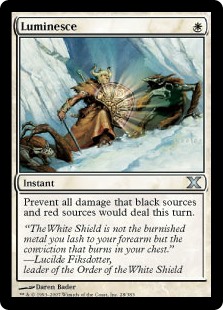 Normally, Fog effects aren't good in Constructed unless they're played in bulk, and even then they're not good against burn. However, Luminesce, which I forgot existed until doing the research for this article, is an exception in this instance. It doesn't prevent combat damage, it prevents damage from all red (or black) sources. For an entire turn. Played in response to a burn spell, it counters not only the spell, but all the prowess triggers they've built up that turn. This can often be a huge tempo and card advantage swing, gaining upwards of 10 life for one mana, and with good follow-up, it becomes game winning. As a bonus, Luminesce is a good answer to all of Storm's win conditions.
Normally, Fog effects aren't good in Constructed unless they're played in bulk, and even then they're not good against burn. However, Luminesce, which I forgot existed until doing the research for this article, is an exception in this instance. It doesn't prevent combat damage, it prevents damage from all red (or black) sources. For an entire turn. Played in response to a burn spell, it counters not only the spell, but all the prowess triggers they've built up that turn. This can often be a huge tempo and card advantage swing, gaining upwards of 10 life for one mana, and with good follow-up, it becomes game winning. As a bonus, Luminesce is a good answer to all of Storm's win conditions.
Breaking the Toolbox
Golgari Yawgmoth has received a lot of attention thanks to Aaron Barich's performance at SCG Knoxville. However, it's been Devoted Company decks, now running Heliod, Sun-Crowned, that are actually putting up results.
I'm not surprised that Yawgmoth is getting attention, nor that it's not putting up results. It's effectively a My First Aggro deck with a sneaky combo kill that makes it good. Because seriously, Young Wolf? In Modern? Devoted Company's been around awhile, and now there's a new reason to try out the deck. It's a proven core with something new to try, so of course it's doing well with more players picking it up. While their gameplans are ultimately very different, they share the same exploitable vulnerabilities, so I'll be treating them the same.
What I'd Use
Grafdigger's Cage
 Cage is far and away the best card against these decks. The tutors are what make the decks and Cage blanks Collected Company, Chord of Calling, Eldritch Evolution, and Finale of Devastation. It also stops the graveyard-based combos, meaning Young Wolf is as terrible as Young Wolf is supposed to be. It's not utterly final, as it does little against naturally-drawn combos from the Devoted decks, but there is no other single card as devastating against these decks as Cage.
Cage is far and away the best card against these decks. The tutors are what make the decks and Cage blanks Collected Company, Chord of Calling, Eldritch Evolution, and Finale of Devastation. It also stops the graveyard-based combos, meaning Young Wolf is as terrible as Young Wolf is supposed to be. It's not utterly final, as it does little against naturally-drawn combos from the Devoted decks, but there is no other single card as devastating against these decks as Cage.
Anger of the Gods
The second-place card is Anger. Both decks are filled with lots of tiny creatures and lack ways to protect them. Anger exiles all it kills, rendering undying meaningless. Given that both decks can run Eternal Witness, normal sweepers tend to suffer. Anger is the best individual removal spell against both decks and is most effective at stabilizing the board. Just beware Burrenton Forge-Tender from Company's board.
What You Shouldn't Use
Ashiok, Mind Render
 Given what I said about Grafdigger's Cage, Ashiok, Mind Render seems like a very good pick. After all, Ashiok also hits Ranger-Captain of Eos and has applications against Titan decks.
Given what I said about Grafdigger's Cage, Ashiok, Mind Render seems like a very good pick. After all, Ashiok also hits Ranger-Captain of Eos and has applications against Titan decks.
The problems here are twofold. The first is that Ashiok does nothing against Collected Company. Chord is common in Devoted decks but not universally played, where every version of either deck I've seen has 4 Company. Ashiok also can't answer the undying creatures.
Finally, as a three-mana planeswalker, Ashiok is too slow and vulnerable. Cage is good because it requires specific answers and costs one mana. Ashiok may hit too late to stop the critical tutor, and can just be attacked to death. Ashiok is decent against the land search decks, but too slow against creature search ones.
Pithing Needle
Pithing Needle shuts down the critical combo pieces of both decks. However, it doesn't stop the search engine, and that's a problem when both decks can just search up Reclamation Sage and break out. Worse, both have sufficient Plan B's to just play through Needle. Name Heliod, lose to Devoted Druid. Name Druid, lose to Viscera Seer. Name Yawgmoth, Thran Physician, just get swung at. Needle ends up too narrow and fragile.
The Spicy Tech
Suppression Field
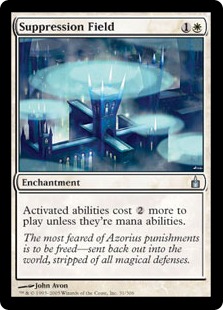 Hey, those are nice infinite combos there. Be a real shame if someone were to tax them all. Field shuts down all the combos by ensuring they can't go infinite and also taxes both decks' fetch-heavy manabase. It is vulnerable to Reclamation Sage, but the mana taxing slightly mitigates this problem. Linvala, Keeper of Silence is of course more robust against these decks, but she's also a harder fit for most lists and more expensive.
Hey, those are nice infinite combos there. Be a real shame if someone were to tax them all. Field shuts down all the combos by ensuring they can't go infinite and also taxes both decks' fetch-heavy manabase. It is vulnerable to Reclamation Sage, but the mana taxing slightly mitigates this problem. Linvala, Keeper of Silence is of course more robust against these decks, but she's also a harder fit for most lists and more expensive.
What's To Come?
As the metagame continues to develop, I expect to see more decks being mis-sideboarded against. Are there some you'd like me to cover? Let me know in the comments.



